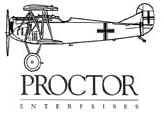|
Most historians will
agree that the Fokker DVII was the best fighter of the Great
War. It is interesting to note, however, that it was neither
the fastest nor the most maneuverable, nor did it possess the best
rate of climb have the most firepower. The DVII's greatest
strength was that it had no weaknesses. When American Ace
Ray Brooks was given the opportunity to fly a captured DVII, he
commented, "I'm glad the war quit when it did 'cause this
DVII is a dandy; light and maneuverable, goes like the deuce and
the motor is a dream."
It took more than the
smooth, powerful, and reliable Mercedes to elevate the DVII to
legendary status. If the motor was the heart of the design,
the wing was surely its soul. Its strength was unparalleled
-- so strong, in fact, that the outerplane N-struts were deemed
unnecessary.
It did not take long
for the Allies to recognize their formidable new opponent.
In September of 1918, the French gave orders to their Spad-13
pilots to avoid combat with the Fokkers, as they were superior on
all accounts except in dives. The DVII proved to be the
culmination of Anthony Fokker's genius.
Over the past 30
years, we have received many requests to produce a wide variety of
models. None has been asked for more often that the Fokker
DVII. We were fortunate to have extensive research material
to draw from for the project. This, combined with the
original example in the Deutsche Museum in Munich, Germany, gave
more than enough reliable material to produce the model. The
team of Ed Newman, Jerry Holcomb, and Bob Sweitzer came together
to produce an exceptional set of plans that could just as easily
be framed and displayed in your living room.
Next, we drew upon our
experience with the Fokker EIII in the construction of the
fuselage. 5/16" maple dowel was again used to simulate
the welded tubular steel framework. The multi-tapered and
beveled scale wing spars were especially challenging. We
found the solution this complex by programming it into a CAD
(Computer-Aided-Design) system and milling it with a
computer-controlled router. The wing ribs were done using
the same method. Parts accuracy and quality are
exceptional. This attention to detail carries over to the
reproduction of the 180HP Mercedes engine as well.
All hardware is
included and features operable brass turnbuckles, machined
fittings, multi-strand rigging and control cables and scale hinge
assemblies. The louvered engine side covers have been
faithfully reproduced in aluminum, fully finished and ready for installation.
We have called upon 30
years of experience to give you our latest addition to the
squadron. We think Mr. Fokker would be pleased!
Click
here to see
more Fokker DVII photos in the Photo Gallery
|


Click
here to see
more Fokker DVII photos in the Photo Gallery
|
KIT
SPECIFICATIONS |
|
Fokker
DVII KIT #1900 |
| Wingspan,
Upper |
88.00" |
| Wingspan,
Lower |
69.00" |
| Overall
Length |
69.00" |
| Overall
Height |
26.75" |
| Wing
Area |
2,056
Sq. " |
| Flying
Weight |
23
Lbs. |
| Engine
(4-stroke) |
2.00
Cu. In. or larger |
| Price |
$925.95
US |
|
Return
to Top |
|
ACCESSORIES |
| #
207-56 |
Aluminum
Disc Wheels |
| #
225 |
Covering
(4 rolls needed) |
| #
351 |
Pilot |
| #
357 |
Pilot |
| #
259 |
Laser
200V 4-Stroke Engine |
| #
257 |
Laser
300V 4-Stroke Engine |
| #
113924 |
Windsock
Datafile 9 |
|
Return
to Top |
|
